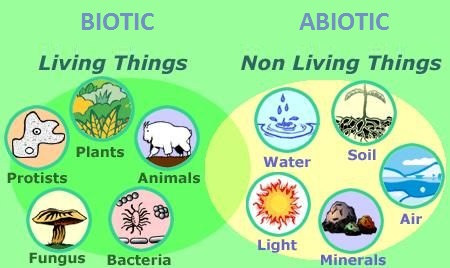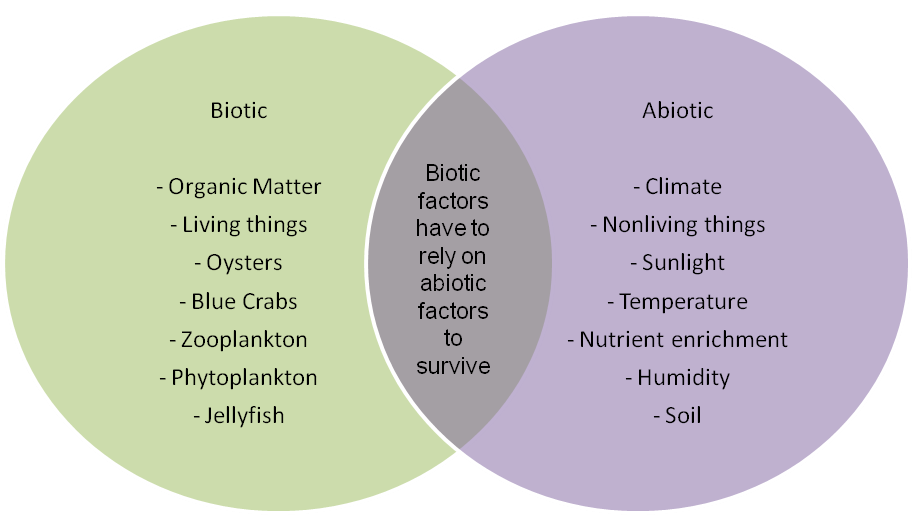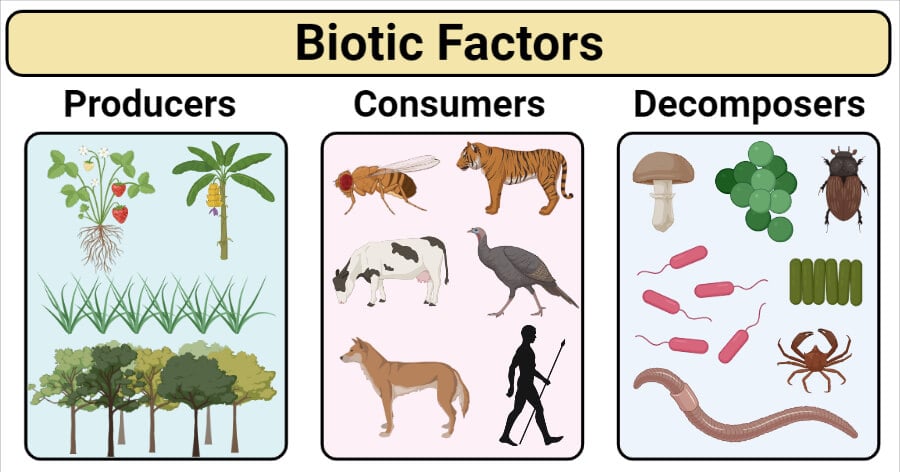Topic ecosystem with abiotic and biotic factors: Explore the fascinating world of ecosystems, where abiotic factors like water and sunlight intertwine with biotic elements such as plants and animals, creating a dynamic web of life that sustains our planet.
Table of Content
- What are the main components that make up an ecosystem in terms of abiotic and biotic factors?
- Understanding Ecosystems: Abiotic and Biotic Components
- The Role of Abiotic Factors in Ecosystems: Water, Soil, and Temperature
- Exploring Biotic Factors: Plants, Animals, Fungi, and Microorganisms
- Interactions Between Abiotic and Biotic Factors
- Energy Flow and Nutrient Cycling in Ecosystems
- The Impact of Abiotic Factors on Biotic Diversity
- YOUTUBE: Biotic and Abiotic Factors in an Ecosystem
- Adaptations of Organisms to Abiotic Conditions
- Case Studies: Examples of Ecosystems and Their Abiotic-Biotic Dynamics
- Human Impacts on Abiotic and Biotic Factors of Ecosystems
- Conservation Strategies for Maintaining Ecosystem Balance
What are the main components that make up an ecosystem in terms of abiotic and biotic factors?
An ecosystem is a complex network of interconnected organisms and their physical environment. It consists of both biotic and abiotic factors, each playing a crucial role in sustaining the ecosystem. Here are the main components that make up an ecosystem in terms of abiotic and biotic factors:
Abiotic Factors:
- Temperature: The average temperature of the ecosystem affects the metabolism and growth of plants and animals.
- Water: Availability of water impacts the survival and distribution of organisms within the ecosystem.
- Light: Sunlight is essential for photosynthesis, which is the primary energy source for most ecosystems.
- Soil: Soil composition, including nutrients, pH level, and texture, influences the types of plants that can grow in an ecosystem.
- Atmosphere: Gases such as oxygen, carbon dioxide, and nitrogen in the air are important for respiration and photosynthesis.
- Topography: The physical features of the land, including elevation and slope, affect the distribution of species within the ecosystem.
- Climate: Climatic conditions like rainfall, humidity, and wind patterns influence the overall structure and functioning of the ecosystem.
Biotic Factors:
- Producers: Plants and other photosynthetic organisms form the base of the food chain by converting sunlight into food energy.
- Consumers: Animals, fungi, and some bacteria are consumers that obtain energy by consuming other organisms.
- Decomposers: Bacteria, fungi, and other organisms break down organic matter, recycling nutrients back into the ecosystem.
- Predators and Prey: The interactions between organisms where some hunt and consume others play a vital role in regulating population sizes.
- Mutualistic Relationships: Symbiotic relationships where different species mutually benefit, such as pollination between flowers and bees, contribute to ecosystem stability.
- Competition: Organisms within an ecosystem may compete for resources like food, water, and shelter.
In summary, an ecosystem consists of a diverse range of abiotic and biotic factors that interact with one another and contribute to the functioning and resilience of the system.
READ MORE:
Understanding Ecosystems: Abiotic and Biotic Components
An ecosystem is a complex network of life, characterized by the interactions between its living (biotic) components and the non-living (abiotic) elements that provide the framework for these interactions. To fully appreciate the intricacies of ecosystems, it"s essential to explore both these components in detail.
- Abiotic Factors: These include the physical and chemical aspects of an environment that influence living organisms. Common examples are:
- Water - crucial for all living beings, affecting their hydration and habitat.
- Temperature - determines the climate and living conditions.
- Light - provides energy through photosynthesis.
- Soil - supports plant life and varies in composition, affecting habitat suitability.
- Air - supplies oxygen for respiration and carbon dioxide for photosynthesis.
- Biotic Factors: These are the living components that affect the ecosystem, including:
- Plants - produce oxygen and food through photosynthesis.
- Animals - range from herbivores that consume plants to carnivores that eat other animals.
- Fungi - decomposers that break down dead organic matter.
- Microorganisms - bacteria and viruses that can both support and challenge other living organisms.
The balance between abiotic and biotic factors is vital for the sustainability of ecosystems. Changes in abiotic factors can significantly impact the biotic community, illustrating the importance of understanding and preserving this delicate balance.

The Role of Abiotic Factors in Ecosystems: Water, Soil, and Temperature
Abiotic factors are non-living elements that play a crucial role in supporting and shaping ecosystems. These include water, soil, and temperature, each contributing uniquely to the environment"s health and the survival of biotic components.
- Water: Essential for all life forms, water acts as a solvent, medium for chemical reactions, and transportation means for nutrients. It influences the distribution of plants and animals based on availability and quality.
- Soil: Comprises minerals, organic matter, water, and air, providing a habitat and nutrients for plants. Soil types and quality affect the types of vegetation that can thrive, impacting the entire food web.
- Temperature: Regulates the metabolic rates of organisms. Different species are adapted to specific temperature ranges, which dictate the geographic distribution of flora and fauna. Temperature variations influence seasonal activities, reproduction, and migration patterns.
Understanding the interplay between these abiotic factors is essential for studying ecosystems, as they determine the conditions for life and the biodiversity within different habitats.
Exploring Biotic Factors: Plants, Animals, Fungi, and Microorganisms
Biotic factors play a crucial role in ecosystems, consisting of all living organisms that interact with one another and their environment. These factors are essential for the balance and health of ecosystems, influencing structure, function, and productivity.
- Plants: Serve as producers in ecosystems, converting sunlight into energy through photosynthesis, forming the base of the food web.
- Animals: Act as consumers, herbivores feed on plants, while carnivores and omnivores consume other organisms, contributing to energy flow and nutrient cycling.
- Fungi: Play a vital role in decomposing organic matter, releasing nutrients back into the soil, and supporting plant growth.
- Microorganisms: Including bacteria and algae, are critical for nutrient cycling, decomposing waste, and maintaining soil health and water quality.
Together, these biotic components interact with abiotic factors, creating complex networks of life that sustain ecosystems. Understanding these interactions is key to preserving biodiversity and ecosystem function.

Interactions Between Abiotic and Biotic Factors
The balance of ecosystems relies on the intricate interactions between abiotic (non-living) and biotic (living) factors. These interactions form the foundation of ecological processes, influencing the survival, growth, and reproduction of organisms.
- Energy Flow: Solar energy, an abiotic factor, is captured by plants (a biotic factor) through photosynthesis, creating food that fuels various trophic levels.
- Nutrient Cycling: Abiotic elements like water and minerals cycle through ecosystems, facilitated by biotic processes such as decomposition and respiration.
- Habitat Formation: Abiotic factors like soil type and water availability determine the distribution of plants and animals, shaping habitats and biomes.
- Climate Interactions: Temperature and precipitation (abiotic factors) directly affect the metabolism, behavior, and distribution of organisms (biotic factors).
- Pollination and Seed Dispersal: Wind and water (abiotic) interact with animals and plants (biotic) in pollination and seed dispersal, essential for plant reproduction.
Understanding these interactions is crucial for conserving biodiversity and managing natural resources, as any change in abiotic factors can significantly impact biotic components and overall ecosystem health.
Energy Flow and Nutrient Cycling in Ecosystems
The flow of energy and cycling of nutrients are fundamental processes that drive the functioning of ecosystems. These interconnected systems ensure the sustainability of life through the conversion and transfer of energy from the sun into chemical energy by producers, and its subsequent flow through consumers and decomposers.
- Photosynthesis and Energy Production: Plants, algae, and some bacteria capture solar energy, converting it into chemical energy through photosynthesis, forming the base of the ecosystem"s energy pyramid.
- Trophic Levels: Energy flows from producers to consumers (herbivores, carnivores, omnivores) and finally to decomposers, with energy being lost as heat at each trophic level.
- Nutrient Cycling: Nutrients like carbon, nitrogen, and phosphorus cycle through abiotic and biotic components of ecosystems, crucial for sustaining life by building and repairing organisms.
- Decomposition: Decomposers break down dead organic matter, returning nutrients to the soil, which are then available for uptake by producers, completing the cycle.
- Human Impact: Human activities can significantly affect these natural cycles, leading to ecosystem imbalance. Conservation efforts aim to protect these essential processes.
Understanding the intricacies of energy flow and nutrient cycling helps highlight the importance of every organism within an ecosystem, revealing the delicate balance that sustains biodiversity and ecosystem health.
The Impact of Abiotic Factors on Biotic Diversity
Abiotic factors, including temperature, light, water, and soil composition, profoundly influence the diversity and distribution of biotic components within ecosystems. These non-living elements shape the environment"s suitability for various species, determining the richness and composition of life in different habitats.
- Temperature regulates enzyme activity and metabolic rates in organisms, affecting growth, reproduction, and survival rates.
- Light availability is crucial for photosynthesis in plants and visibility for predators and prey, influencing species" spatial distribution and activity patterns.
- Water availability dictates the living conditions for aquatic and terrestrial life, influencing species diversity particularly in arid and semi-arid regions.
- Soil types and nutrients support different plant species, which in turn support diverse animal communities through food webs.
The interplay between these abiotic factors creates unique ecosystems, from lush rainforests to arid deserts, each with a distinct set of biotic components adapted to their environment. Understanding the impact of abiotic factors on biotic diversity is crucial for conserving biodiversity and managing natural resources sustainably.
Biotic and Abiotic Factors in an Ecosystem
Explore the fascinating world of ecosystems and discover the delicate balance between plants, animals, and their environment. Watch this captivating video to gain a deeper understanding of how these interconnected systems thrive and how we can protect them for future generations.
GCSE Biology - Biotic and Abiotic Factors
Are you studying for your GCSE Biology exams? Watch this informative video that covers all the key topics you need to know. From cell structure to genetics, this comprehensive review will help you ace your exam and boost your confidence in no time.
Adaptations of Organisms to Abiotic Conditions
Organisms exhibit remarkable adaptations to cope with the abiotic conditions of their ecosystems. These adaptations enable life to flourish in diverse and sometimes extreme environments.
- Water Conservation: In arid environments, plants like cacti have thickened leaves to store water and reduce transpiration. Animals may produce concentrated urine to minimize water loss.
- Temperature Regulation: Polar bears have thick fur and fat layers for insulation against cold, while desert animals may be nocturnal to avoid daytime heat.
- Salinity Adaptation: Mangroves expel salt through their leaves, and some fish can regulate their internal osmolarity to tolerate varying salinity levels.
- Light Utilization: Deep-sea organisms exhibit bioluminescence for attracting mates or prey, while forest floor plants may have large leaves to capture minimal sunlight.
These adaptations are evolutionary responses to the challenges posed by abiotic factors, ensuring survival, reproduction, and the maintenance of biodiversity within ecosystems.

Case Studies: Examples of Ecosystems and Their Abiotic-Biotic Dynamics
Ecosystems around the world present unique interactions between abiotic and biotic factors, demonstrating nature"s adaptability and diversity. From the rainforests of the Amazon to the deserts of the Sahara, each ecosystem offers valuable insights into the balance of life. Here are examples of how abiotic and biotic components shape distinct environments:
- Amazon Rainforest: High humidity and rainfall support diverse plant and animal life, showcasing how climate (abiotic) influences biodiversity (biotic).
- Sahara Desert: Extreme temperature and scarce water highlight organisms" adaptations to abiotic stress, maintaining biotic diversity despite harsh conditions.
- Great Barrier Reef: Water temperature and sunlight affect coral growth (abiotic), which in turn supports a wide range of marine species (biotic).
- Arctic Tundra: Cold temperatures and permafrost shape a unique biome where the hardy biotic community thrives amidst challenging abiotic factors.
These case studies exemplify the intricate connections between abiotic conditions and biotic resilience, underlining the importance of preserving ecosystems worldwide.
Human Impacts on Abiotic and Biotic Factors of Ecosystems
Human activities significantly influence both abiotic and biotic components of ecosystems worldwide. From urbanization and pollution to climate change and deforestation, the impacts are profound and far-reaching, affecting water quality, soil health, air temperature, and the diversity of life.
- Pollution from industrial, agricultural, and domestic sources contaminates water bodies and soil, altering their chemical composition and affecting the organisms that rely on these habitats.
- Deforestation and urbanization change land use patterns, leading to habitat loss for many species and altering the physical characteristics of the land, which in turn affects local climate and soil conditions.
- Climate change, driven by the emission of greenhouse gases, impacts temperature, precipitation patterns, and sea levels, affecting both abiotic elements like water and temperature and biotic factors by shifting species distributions and altering growth patterns.
- Overexploitation of resources, such as overfishing and unsustainable agriculture, directly impacts the biotic components by reducing biodiversity and disrupting food webs.
Addressing these impacts requires global cooperation and sustainable management practices aimed at preserving ecosystem integrity while fulfilling human needs.

READ MORE:
Conservation Strategies for Maintaining Ecosystem Balance
Preserving the delicate balance between abiotic and biotic factors in ecosystems is crucial for sustaining biodiversity and the services ecosystems provide. Effective conservation strategies involve a multifaceted approach that includes:
- Protected Areas: Establishing and managing national parks, reserves, and wildlife sanctuaries to safeguard habitats and species.
- Restoration Projects: Rehabilitating degraded ecosystems, such as wetlands, forests, and grasslands, to restore their ecological integrity and functionality.
- Sustainable Practices: Promoting sustainable agriculture, forestry, and fishing practices to minimize environmental impact and conserve resources.
- Climate Change Mitigation: Reducing greenhouse gas emissions and implementing adaptation strategies to address the impacts of climate change on ecosystems.
- Community Engagement: Involving local communities in conservation efforts, recognizing their knowledge and stake in the health of ecosystems.
- Policy and Legislation: Enacting and enforcing laws and regulations that protect ecosystems and their components from exploitation and degradation.
- Research and Monitoring: Conducting scientific research and ongoing monitoring to better understand ecosystems and the effects of conservation measures.
Through these strategies, it is possible to maintain ecosystem balance and ensure the continued provision of essential ecosystem services, such as clean water, air, and fertile soil, which are vital for life on Earth.
In understanding ecosystems, recognizing the synergy between abiotic and biotic factors illuminates the path to sustainability. By cherishing and protecting this balance, we ensure a thriving planet for future generations.






